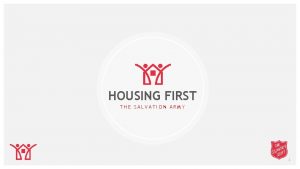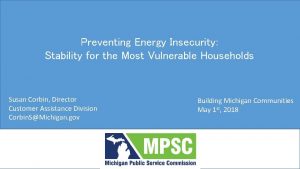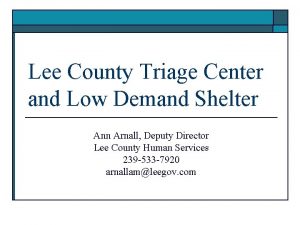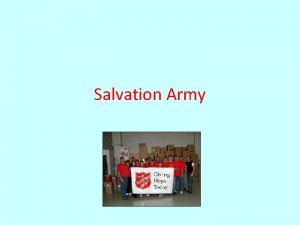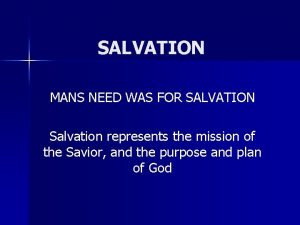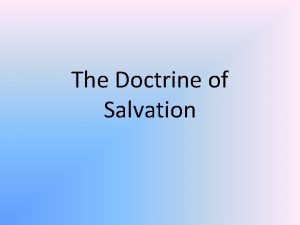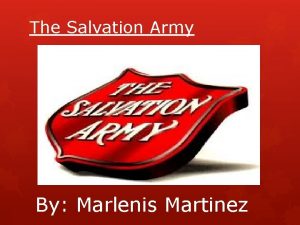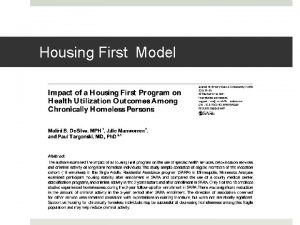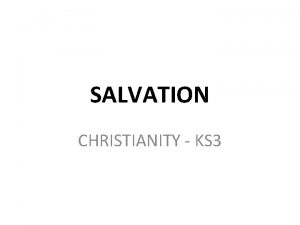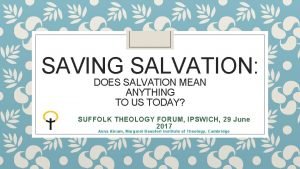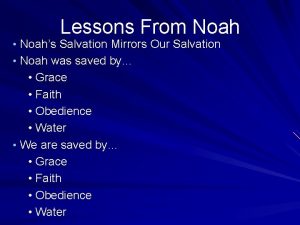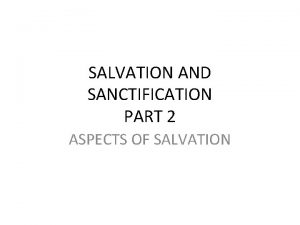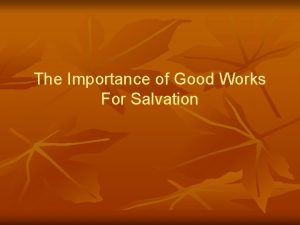HOUSING FIRST THE SALVATION ARMY 1 HOUSING FIRST


























- Slides: 26

HOUSING FIRST THE SALVATION ARMY 1

HOUSING FIRST AND HARM REDUCTION CONTENTS 04 05 06 07 08 09 SALVATION ARMY REGIONAL PORTFOLIO HOUSING FIRST CARDIFF TEAM HOUSING FIRST MERTHYR TYDFIL TEAM WELSH PRINCIPLES THE SALVATION ARMY AND HARM REDUCTION THE SALVATION ARMY HARM REDUCTION PRINCIPLES 10 14 21 22 23 25 THE HARM IN TRANSITIONAL SYSTEMS HOUSING FIRST AND HARM REDUCTION THE JOURNEY TOWARDS AUTONOMY QUANTITATIVE OUTCOMES QUALITATIVE OUTCOMES STORIES 2

HOUSING FIRST AND HARM REDUCTION SALVATION ARMY REGIONAL PORTFOLIO The Salvation Army International church and charity Wales and South West Region Covering the South West of England Wales Our Homeless Services Unit portfolio in Wales includes; Floating Support Services 300 units of support across Cardiff – single people, couples and families Young People Services Northlands Life House, Supported Housing and Young Persons Floating Support. Adult Services Ty Gobaith Life House (Compass Project and Bridge Programme), Devonport Life House and Zion House. Outreach Services Reconnection Service, The Bus Project and Housing First Cardiff and Merthyr Tydfil. 3

HOUSING FIRST AND HARM REDUCTION HOUSING FIRST CARDIFF TEAM Project Manager (FT), Administrative Assistant (PT), Programme Coordinator (PT), Specialist Support Workers (FT), Assistant Support Workers (FT) • Original funding grant – June 2017 • Currently funded until – March 2021 • 20 tenancies still currently active. • Funded directly by Welsh Government with partner project Cardiff Council • • Funded to deliver 25 units of support Support is flexible hours Monday to Friday, flexible weekend appointments to meet need with additional on call. • • Since the start of the project we have created 23 tenancies 9 individuals taking part in ‘Assertive Outreach’ support, awaiting a property and the 3 previous tenants we continue to work with to help them to gain a new home. 4

HOUSING FIRST AND HARM REDUCTION HOUSING FIRST MERTHYR TYDFIL TEAM Project Manager (FT), Prevention Worker (FT), Specialist Support Workers (FT), Assistant Support Worker (FT) • Original funding grant – November 2018 • Currently funded until – March 2021 • Funded directly by Welsh Government via partner Merthyr Tydfil Local Authority • Funded to deliver 8 units of support • Since the start of the project we have created 5 tenancies • 4 tenancies still currently active. • 4 individuals taking part in ‘Assertive Outreach’ support awaiting a property. • Support is flexible hours Monday to Friday, flexible weekend appointments to meet need with additional on call. • Additional commission in September 2020 to create post ‘Intensive Homeless Prevention Worker’ to support complex individuals already in the community, who would otherwise become homeless if not for specialist intervention until March 2021. 5

HOUSING FIRST AND HARM REDUCTION WELSH PRINCIPLES 1. People have a right to a home that is affordable, secure, habitable, adequate both physically and culturally, and with availability of services. It should also be dispersed in the community and not as part of an institution. 2. Flexible support is provided for as long as it is needed. 3. Housing and support are separated 4. The service is targeted at individuals who demonstrate a repeat pattern of disengagement with hostel accommodation and/or, individuals accessing rough sleeping or accessing EOS (Emergency Overnight Stay) at the point when the referral is made. 5. Individuals have choice and control 6. A harm reduction approach to substance misuse is used. 7. The service is delivered in a psychologically-informed, trauma informed way that is sensitive and aware of protected characteristics. 8. An active engagement approach is used. 9. The service is based on people’s strengths, goals and aspirations, and as such has an explicit commitment to a small caseload. 6

HOUSING FIRST AND HARM REDUCTION THE SALVATION ARMY AND HARM REDUCTION Over the past decade The Salvation Army have been on a transformative journey, moving from services that promote abstinence to services that promote choice. Practical, social and spiritual interventions focused on wellbeing Focus on strengthening resilience and addressing specific causes and consequences Seeking to understand the profound and enduring nature of trauma and understand that substance use is an action taken to relieve pain and discomfort. Environment, culture and social relationships 7

HOUSING FIRST AND HARM REDUCTION THE SALVATION ARMY – HARM REDUCTION PRINCIPLES 01 02 03 04 05 A set of practical strategies and ideas to meet service users where they’re at to reduce negative consequences associated with substance use and any other harmful behaviours. Approaches are inclusive rather than enforced and aim to reinforce positive change in person’s life, no matter how small or incremental that change may be, giving service users a real voice in the creation of programs and policies designed to serve them. Recognises that the realities of poverty, class, racism, social isolation, past trauma, sex-based discrimination and other social inequalities affect both people’s vulnerability and capacity for effectively dealing with harmful behaviours. Understands substance use/coping strategies as complex, encompassing a continuum of behaviours from severe use to abstinence, and acknowledges that some ways of using drugs are safer than others. This approach works to minimize its harmful effects rather than simply ignore or condemn them. Calls for the nonjudgmental, non-coercive provision of services to people who use drugs and the communities in which they live in order to assist them in reducing harm. 8

HOUSING FIRST AND HARM REDUCTION THE HARM IN TRANSITIONAL SYSTEMS The majority of supported housing in the UK is a transitional staircase model where rough sleepers move through levels of support towards independent living. In the Salvation Army our large hostels move on around 75% of individuals positively. Transitional spaces work really well for a lot of people. However, among the 25% who are not successful, there a growing proportion of rough sleepers who have attempted multiple times to navigate this journey without success. Each time they experience eviction or abandonment and the barriers to re-entering services become greater and more complex. 9

HOUSING FIRST AND HARM REDUCTION THE HARM IN TRANSITIONAL SYSTEMS Navigating transitional systems and spaces is often conditional on an individual’s behaviour. There is a perceived lack of choice for participants in transitional systems. Difficulties in providing a customised approach to support. Transitional systems and spaces are often big and busy environments. Big and busy spaces are often breeding grounds for transference. It is hard to build trust with multiple professionals. If the individual is unable to navigate the system, they often have to go back to the start. 10

HOUSING FIRST THE HARM IN TRANSITIONAL SYSTEMS Self contained - own space that’s safe. Far less conditionality around behaviour and lifestyle choices. Support is one to one with fewer professionals which makes it easier to build trust. Support is bespoke and personal. The support is there to solely advocate for the individual and remain impartial. The neighbours/persons around the individual are more secure and stable. If the initial home offer isn’t right, a new offer is made. Stopping the need to restart the journey. 11

HOUSING FIRST AND HARM REDUCTION RESEARCH Permanent Housing - High autonomy Consistent relationships Lower risk of harm Housing First Model Transitional Housing/Hostel Shelter/Emergency Placement Street Homeless - Limited autonomy Fragmented relationships High risk of harm 12

HOUSING FIRST AND HARM REDUCTION The principles of Housing First are grounded within harm reduction. Housing First meets individuals where they are at, removing systematic barriers and agency driven goals around abstinence and reduction of substance use. Housing First acknowledges a persons substance use as part of the complex nature of that person and helps that person to make safer choices around their substance use by creating safety, reparative relationships and over time supporting that person to develop their autonomy. 13

HOUSING FIRST AND HARM REDUCTION RESEARCH High housing retention rates (Mares & Rosenheck, 2007; Perlman & Parvensky, 2006) Fewer hospitalisations (Sadowski et al. , 2009) Higher perceived choice in services (Greenwood et al. , 2005; Tsemberis, Gulcur, & Nakae, 2004) Reduced substance use (Padgett et al. , 2010) Reduced involvement in criminal activity (De. Silva, Manworren, & Targonski, 2011) 14

Within Housing First - the pathway to safety, the development of a reparative relationship and the gradual move to autonomy is a journey that the individual and the staff team enter into together. 15

Greater autonomy Client Team + Increase safety = Reparative relationships = Reduced harm Less intervention 16

HOUSING FIRST AND HARM REDUCTION REDUCING HARM TO INDIVIDUALS BY CREATING SAFETY The offer of a home. Permanence, identity and trust. That the person is valued, trusted and cared about. Choice. Having a home provides a safer alternative to street based substance use. It offers opportunities to divert focus away from using substances through stabilising support and diversionary activities. 17

HOUSING FIRST AND HARM REDUCTION REDUCING HARM TO STAFF BY CREATING SAFETY Values based recruitment process focusing or empathy, passion and emotional resilience. Extensive training pathway. Key frame works; PIE, ACEs, Trauma Informed Practise. Keen focus on staff wellbeing with specific training around emotional regulation. Developing close team relationships through ongoing coaching and mentoring. One to one reflective practise across team members in all roles. On the ground leadership and management. Flexible approach to working hours and work base to help to manage emotional wellbeing and ensure a positive work life balance. 18

HOUSING FIRST AND HARM REDUCTION BUILDING REPARATIVE RELATIONSHIPS Survive and thrive. Reparative relationships. Time and space. Creating safety and trust. Equal and collaborative. Non-coercive and non-judgmental. Caring. Values the individual. 19

HOUSING FIRST AND HARM REDUCTION BUILDING PROFESSIONAL RELATIONSHIPS Multi-disciplinary Steering Group The Steering Group process is a key part of: Reducing re-traumatisation for clients. Promoting understanding about the client. Reducing harm for the individual and their new community by the effective sharing of information. Ongoing strategic level relationships with partners. The importance of nurturing operational relationships. 20

HOUSING FIRST AND HARM REDUCTION THE JOURNEY TOWARDS AUTONOMY Safety + Reparative Relationships = Reduces Harm Promoting confidence and self worth by focusing on diversionary activities that are lead by clients and their interests. Success is noticed. Developing confidence – brokering relationships. Accompany. Support. Reflect. Consistent support that can intensify and wrap around the person when there are dips in the road. Unconditional positive regard. Respectfully challenging where appropriate. 21

HOUSING FIRST AND HARM REDUCTION QUANTITATIVE OUTCOMES 83% Continue to live positively in the community in their own home. 100% 93% 100% Have engaged with harm reduction support in relation to substance use and health concerns. Have successfully worked with the project teams to reduce their engagement with criminal and antisocial activity. Feel physically more healthy and able since receiving support. Feel safer and mentally well, that their emotions are more manageable. 22

HOUSING FIRST AND HARM REDUCTION CLIENT QUALITATIVE OUTCOMES ‘‘I feel I can achieve more with intensive support and my mental health is improving’’ "I have… started Buvidal and no longer crave heroin or any other substances. This has helped me to start thinking clear again and begin enjoying the things I love again like music and writing" “If I ever need anything they are always there” “Having a house has woken me up because I’ve got bills to pay now and so I’m not spending all my money on drink” “I feel like my life is getting back on track, having the flat and being off the Heroin has helped me get my confidence back and also I have been able to be creative again and do the things I love” “I feel more stable in my life and more confident about myself” 23

HOUSING FIRST AND HARM REDUCTION TEAM QUALITATIVE OUTCOMES “Housing First is a model which is created solely around the client. From the project values to the way in which staff work with clients, our safety, and how the relationship then evolves. ” “I’ve found that working in this service compared to other services I’ve worked with in the past, there’s a feeling that person-centredness is at the heart of everything we do” “I am so proud to be a part of such an amazing team” “We work alongside individuals and empower them to explore what path they would next like to take in life - individuals who previously felt they had no paths left to take. It’s an experience that is humbling and unique. ” “I have known many of our Housing First clients for many years. Before this project I never believed that I would see people who had lead such challenging lives find such safety and comfort in their home” “Housing First without a doubt is demonstrating that with unconditional support, our clients are able to make strides for the better“ 24

HOUSING FIRST AND HARM REDUCTION STORIES 25

HOUSING FIRST AND HARM REDUCTION ANY QUESTIONS? WHAT? WHY? WHERE? WHEN? WHO? HOW? CARA. FORSEY@SALVATIONARMY. ORG. UK CATHERINE. DOCHERTY@SALVATIONARMY. ORG. U K THANKS… 26
 What denomination is the salvation army
What denomination is the salvation army Salvation army adherent
Salvation army adherent The salvation army symbols
The salvation army symbols Salvation army hostel cardiff
Salvation army hostel cardiff Dte lsp number
Dte lsp number Salvation army triage
Salvation army triage Combined arms training strategies
Combined arms training strategies Led first roman army to britain
Led first roman army to britain Hát kết hợp bộ gõ cơ thể
Hát kết hợp bộ gõ cơ thể Slidetodoc
Slidetodoc Bổ thể
Bổ thể Tỉ lệ cơ thể trẻ em
Tỉ lệ cơ thể trẻ em Voi kéo gỗ như thế nào
Voi kéo gỗ như thế nào Chụp phim tư thế worms-breton
Chụp phim tư thế worms-breton Chúa yêu trần thế
Chúa yêu trần thế Các môn thể thao bắt đầu bằng tiếng chạy
Các môn thể thao bắt đầu bằng tiếng chạy Thế nào là hệ số cao nhất
Thế nào là hệ số cao nhất Các châu lục và đại dương trên thế giới
Các châu lục và đại dương trên thế giới Công thức tính độ biến thiên đông lượng
Công thức tính độ biến thiên đông lượng Trời xanh đây là của chúng ta thể thơ
Trời xanh đây là của chúng ta thể thơ Cách giải mật thư tọa độ
Cách giải mật thư tọa độ Phép trừ bù
Phép trừ bù độ dài liên kết
độ dài liên kết Các châu lục và đại dương trên thế giới
Các châu lục và đại dương trên thế giới Thơ thất ngôn tứ tuyệt đường luật
Thơ thất ngôn tứ tuyệt đường luật Quá trình desamine hóa có thể tạo ra
Quá trình desamine hóa có thể tạo ra Một số thể thơ truyền thống
Một số thể thơ truyền thống



